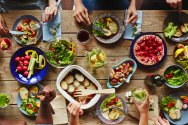
Background
Six dilemmas – part 6: How to steer consumer behaviour?
A transition towards a sustainable food system can only be achieved if the food system as a whole, including consumer behaviour, is addressed. As long as we fail to select healthy and sustainable options in the supermarket, the food system will continue to impact the climate, environment and biodiversity significantly. This impact is often increased as a result of the growth in the global population, increasing wealth (causing a rise in meat consumption) and urbanisation.
How can we ensure that the world’s population has access to sustainable, healthy, affordable and culturally acceptable food? Not an easy task, as the true societal costs of food products are frequently not included in the price, robbing chain parties and consumers of the correct cost incentives. We want to transition towards a food system in which sustainably produced food is cheaper and more profitable than less sustainable and unhealthier food.
Influencing and freedom of choice
But leading consumption is a sensitive issue. In the Netherlands, we value the consumers’ individual freedom of choice. We may try to steer consumption through labels and quality assurances, but this has a limited impact. Far-reaching interference, through, for example, a meat tax, is met with objections and resistance. At the same time, we are aware that our consumer behaviour is steered by advertisements, sales and the way shops are designed. Putting meat on sale has been a proven strategy in supermarkets for years.
What instruments are there to change our consumer behaviour? With minimal nudging, we expect the consumer to make their own sensible choices, but in practice, consumers choose products that are cheap and convenient rather than those that are better for the climate, biodiversity and their health. Minimal nudging is, thus, insufficient. The range of options increases when we opt for more influence. Targeted taxes, such as a meat tax or sugar tax, are effective but controversial.
Targeted taxes, however, ignore the food environment and economic incentives. Truly changing consumer patterns requires incentives to which market parties will respond, such as including undesired external effects in the price and sector-wide sustainability agreements. Technology may also play a role, for example, through individual food programmes based on biometry (data about our body) that include advice on sustainable and healthy food options.
Part of the food system
Whatever the options we choose, we cannot consider them as separated from the food system. Given the fact that food systems are often international and complex and a part of the food produced in the Netherlands is destined for export, we must take the global perspective into account and consider whether our consumption and production contribute to unsustainable behaviour abroad.
In the Netherlands, there is little political backing to intervene in our food consumption. The reluctance to steer our food choices contrasts sharply with the generally accepted use of pricing incentives to discourage the use of fossil fuels, tobacco and alcohol.
Link: the six dilemmas we have discussed are linked in numerous ways. Hence, it is essential to consider the dilemmas in conjunction with each other, as every choice within a dilemma affects another.
6 dilemmas
The societal debate on agriculture and nature frequently focuses on slashing the livestock population in half and whether we should aim to achieve the nitrogen targets in 2030 or in 2035. But are there the right questions? A group of Wageningen researchers identified six dilemmas contributing to the Netherlands’ future course of agriculture and nature.
In the series “6 Dilemmas”, each of the dilemmas is discussed in more detail.


